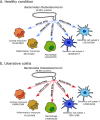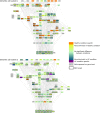Extracellular vesicles produced by the human commensal gut bacterium Bacteroides thetaiotaomicron affect host immune pathways in a cell-type specific manner that are altered in inflammatory bowel disease
- PMID: 35064769
- PMCID: PMC8783345
- DOI: 10.1002/jev2.12189
Extracellular vesicles produced by the human commensal gut bacterium Bacteroides thetaiotaomicron affect host immune pathways in a cell-type specific manner that are altered in inflammatory bowel disease
Abstract
The gastrointestinal (GI) tract harbours a complex microbial community, which contributes to its homeostasis. A disrupted microbiome can cause GI-related diseases, including inflammatory bowel disease (IBD), therefore identifying host-microbe interactions is crucial for better understanding gut health. Bacterial extracellular vesicles (BEVs), released into the gut lumen, can cross the mucus layer and access underlying immune cells. To study BEV-host interactions, we examined the influence of BEVs generated by the gut commensal bacterium, Bacteroides thetaiotaomicron, on host immune cells. Single-cell RNA sequencing data and host-microbe protein-protein interaction networks were used to predict the effect of BEVs on dendritic cells, macrophages and monocytes focusing on the Toll-like receptor (TLR) pathway. We identified biological processes affected in each immune cell type and cell-type specific processes including myeloid cell differentiation. TLR pathway analysis highlighted that BEV targets differ among cells and between the same cells in healthy versus disease (ulcerative colitis) conditions. The in silico findings were validated in BEV-monocyte co-cultures demonstrating the requirement for TLR4 and Toll-interleukin-1 receptor domain-containing adaptor protein (TIRAP) in BEV-elicited NF-kB activation. This study demonstrates that both cell-type and health status influence BEV-host communication. The results and the pipeline could facilitate BEV-based therapies for the treatment of IBD.
Keywords: extracellular vesicles; host-microbe interactions; single-cell data analysis; toll-like receptor pathway; ulcerative colitis.
© 2022 The Authors. Journal of Extracellular Vesicles published by Wiley Periodicals, LLC on behalf of the International Society for Extracellular Vesicles.
Conflict of interest statement
The authors report no conflict of interest.
Figures








References
-
- Arenas, J. (2012). The role of bacterial lipopolysaccharides as immune modulator in vaccine and drug development. Endocrine, Metabolic & Immune Disorders Drug Targets, 12, 221–235. - PubMed
-
- Aslan, M. , Nazligul, Y. , Bolukbas, C. , Bolukbas, F. F. , Horoz, M. , Dulger, A. C. , Erdur, F. M. , Celik, H. , & Kocyigit, A. (2011). Peripheral lymphocyte DNA damage and oxidative stress in patients with ulcerative colitis. Polskie Archiwum Medycyny Wewnetrznej, 121, 223–229.</bib22> - PubMed
-
- Beltrán, B. , Nos, P. , Dasí, F. , Iborra, M. , Bastida, G. , Martínez, M. , Oʼconnor, J.‐E. , Sáez, G. , Moret, I. , & Ponce, J. (2010). Mitochondrial dysfunction, persistent oxidative damage, and catalase inhibition in immune cells of naïve and treated Crohn's disease. Inflammatory Bowel Diseases, 16, 76–86. - PubMed
-
- Boele J., Persson H., Shin J. W., Ishizu Y., Newie I. S., Sokilde R., Hawkins S. M., Coarfa C., Ikeda K., Takayama K.‐i., Horie‐Inoue K., Ando Y., Burroughs A. M., Sasaki C., Suzuki C., Sakai M., Aoki S., Ogawa A., Hasegawa A., Lizio M., Kaida K., Teusink B., Carninci P., Suzuki H., Inoue S., Gunaratne P. H., Rovira C., Hayashizaki Y., del Hoon M. J. L. (2014). PAPD5‐mediated 3' adenylation and subsequent degradation of miR‐21 is disrupted in proliferative disease. Proceedings of the National Academy of Sciences, 111(31), 11467–11472. 10.1073/pnas.1317751111 - DOI - PMC - PubMed
Publication types
MeSH terms
Substances
Grants and funding
- BB/M011216/1/BB_/Biotechnology and Biological Sciences Research Council/United Kingdom
- BB/J004529/1/BB_/Biotechnology and Biological Sciences Research Council/United Kingdom
- BB/R012490/1/BB_/Biotechnology and Biological Sciences Research Council/United Kingdom
- BB/CSP17270/1/BB_/Biotechnology and Biological Sciences Research Council/United Kingdom
- BBS/E/F/000PR10355/BB_/Biotechnology and Biological Sciences Research Council/United Kingdom
- BBS/E/F/000PR10356/BB_/Biotechnology and Biological Sciences Research Council/United Kingdom
- BB/P016774/1/BB_/Biotechnology and Biological Sciences Research Council/United Kingdom
- BBS/E/F/000PR10353/BB_/Biotechnology and Biological Sciences Research Council/United Kingdom
- DH_/Department of Health/United Kingdom
LinkOut - more resources
Full Text Sources
Molecular Biology Databases

